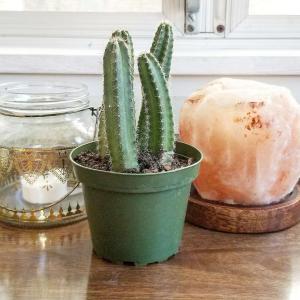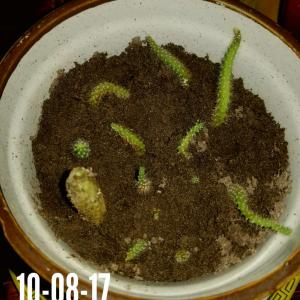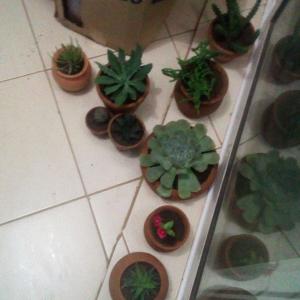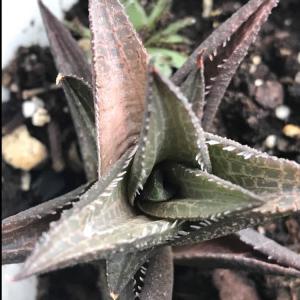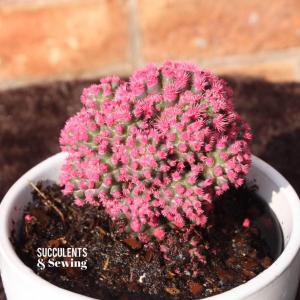文章
Dummer. ゛☀
2017年10月02日

False Peyote (Ariocarpus fissuratus) is a small cactus that grows only a few centimeters in height and about 4-6 inches in diameter. Its nodes end in pointed triangles, giving the cactus a star-like appearance. The flowers are pink-violet in color. These little cacti are often mistaken for rocks in the stony desert in which they grow and are therefore difficult to find. Ariocarpus fissuratus is found only in New Mexico, northern Mexico and southwest Texas.
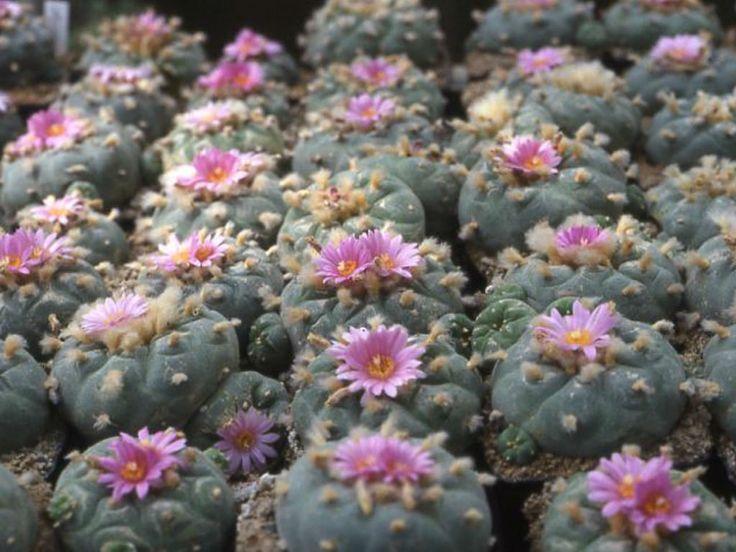
Traditional Uses
Ariocarpus fissuratus is usually referred to as false or dangerous Peyote, and has been known in the Americas since pre-Columbian times. This cactus was very possibly used as a Peyote substitute when Peyote was unavailable. The Huichol strongly warn against consuming Ariocarpus fissuratus, and associate it with dark sorcery. They believe that those individuals who do not properly purify themselves at the start of the Peyote hunt pilgrimage by admitting all of their sexual encounters outside of marriage may mistake Ariocarpus fissuratus for real Peyote, the consumption of which will result in a deliriant-hallucinogenic state. The Tarahumara, meanwhile, consider they to be even more powerful than Peyote.
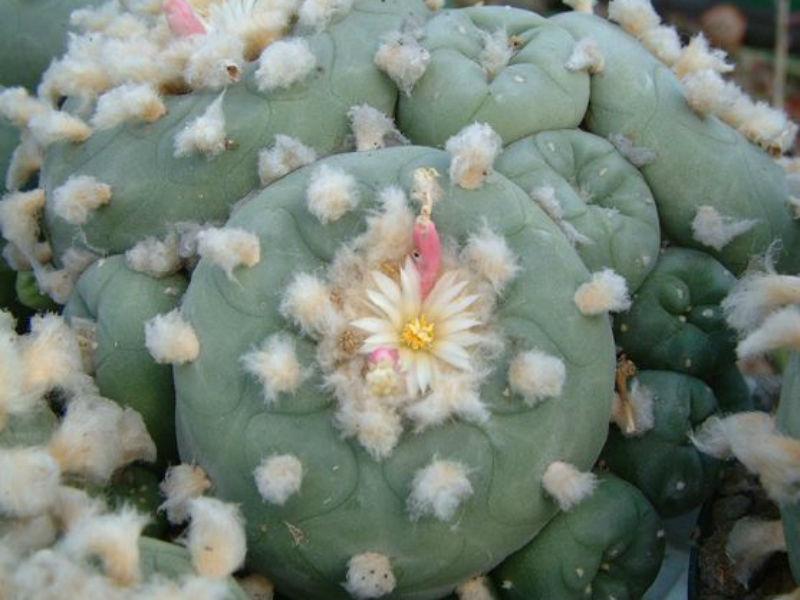
Medicinal Uses
Ariocarpus fissuratus, and the related Ariocarpus retusus may have been used to treat malaria by some peoples in Mexico. The related Ariocarpus kotschoubeyanus is used as an external medicine to treat wounds. Certain reports of the consumption of Ariocarpus fissuratus also mention that it has strong narcotic pain-killing properties.

Traditional Uses
Ariocarpus fissuratus is usually referred to as false or dangerous Peyote, and has been known in the Americas since pre-Columbian times. This cactus was very possibly used as a Peyote substitute when Peyote was unavailable. The Huichol strongly warn against consuming Ariocarpus fissuratus, and associate it with dark sorcery. They believe that those individuals who do not properly purify themselves at the start of the Peyote hunt pilgrimage by admitting all of their sexual encounters outside of marriage may mistake Ariocarpus fissuratus for real Peyote, the consumption of which will result in a deliriant-hallucinogenic state. The Tarahumara, meanwhile, consider they to be even more powerful than Peyote.

Medicinal Uses
Ariocarpus fissuratus, and the related Ariocarpus retusus may have been used to treat malaria by some peoples in Mexico. The related Ariocarpus kotschoubeyanus is used as an external medicine to treat wounds. Certain reports of the consumption of Ariocarpus fissuratus also mention that it has strong narcotic pain-killing properties.
0
1
文章
Dummer. ゛☀
2017年10月02日

Old movies and television programs have made Barrel Cactus famous. For years, popular media touted the Barrel Cactus as a provider of life-saving water for lost and thirsty travelers. The story was based on the cactus’ remarkably juicy interior that could be squeezed to release a distasteful fluid. A recent chemical evaluation of the liquid, however, indicates it is too alkaline to quench one’s thirst. In truth, a person would be worse off after drinking it. The Seri Indians of Mexico’s Sonoran Desert were aware of this fact and described how the liquid was not considered potable and caused headaches, diarrhea and pain in the extremities if consumed.

The California Barrel Cactus (Ferocactus cylindraceus) was introduced to the scientific community by German-born botanist George Engelmann in 1853. He characterized the species as having a cylindrical shape, vertical rows of curved spines and large yellow blossoms often forming a circular crown on top of a single, swollen stem. (Most plants have one stem though occasionally multi-stemmed individuals are found. The condition is thought to be a result of rodents or other mammals gnawing the less well-armed base of the plant.) Providing a cactus does not succumb to multiple-years of drought, depredations of woodrats searching for moist food, or being carried away by a flash flood, a Barrel Cactus can survive for nearly a century. Such old plants may reach ten feet in height and may finally die when toppled by strong winds.
In historic times, all products of the plant’s reproductive cycle were collected by Native Americans. In spring, Indian women collected buds and flowers. In summer ripened fruits were harvested. In both seasons reproductive parts were plucked from the top of cacti with sticks to avoid sharp spines. Buds, flowers and fruits were parboiled to remove bitterness. After cooking, harvested parts were either eaten immediately or sun dried and stored.

There are twenty-five species in the genus Ferocactus with the largest number occurring in Mexico. Only Ferocactus cylindraceus occurs in the deserts of California. A second species, Ferocactus viridescens (San Diego Barrel Cactus), is found on the coastal side of the mountains in Southern California’s San Diego County. Two additional species, Ferocactus wislizeni (Arizona Barrel Cactus) and Ferocactus covillei (Coville’s Barrel Cactus) also occur in the Sonoran Desert but only in Arizona and adjacent Mexico.

California Barrel Cacti are found on coarse-grained (well-drained) soils of hillsides, alluvial fans and bajadas in both the Sonoran and Mojave deserts of California. The species is particularly abundant on eastern slopes of the Peninsular Ranges and in the eastern Mojave Desert. Both locations are centered where summer rains are more likely than in other parts of the desert. The species has been discovered at elevations up to 5,000 feet on south-facing slopes.
In the Coachella Valley, the best places to view and photograph California Barrel Cacti include the Indian Canyons Tribal Park south of Palm Springs and Devil’s Garden about 1.5 miles (2.4 km) northwest of Highway 62 on Mission Creek Road. At the latter location, park at the concrete berm and walk directly west.

The California Barrel Cactus (Ferocactus cylindraceus) was introduced to the scientific community by German-born botanist George Engelmann in 1853. He characterized the species as having a cylindrical shape, vertical rows of curved spines and large yellow blossoms often forming a circular crown on top of a single, swollen stem. (Most plants have one stem though occasionally multi-stemmed individuals are found. The condition is thought to be a result of rodents or other mammals gnawing the less well-armed base of the plant.) Providing a cactus does not succumb to multiple-years of drought, depredations of woodrats searching for moist food, or being carried away by a flash flood, a Barrel Cactus can survive for nearly a century. Such old plants may reach ten feet in height and may finally die when toppled by strong winds.
In historic times, all products of the plant’s reproductive cycle were collected by Native Americans. In spring, Indian women collected buds and flowers. In summer ripened fruits were harvested. In both seasons reproductive parts were plucked from the top of cacti with sticks to avoid sharp spines. Buds, flowers and fruits were parboiled to remove bitterness. After cooking, harvested parts were either eaten immediately or sun dried and stored.

There are twenty-five species in the genus Ferocactus with the largest number occurring in Mexico. Only Ferocactus cylindraceus occurs in the deserts of California. A second species, Ferocactus viridescens (San Diego Barrel Cactus), is found on the coastal side of the mountains in Southern California’s San Diego County. Two additional species, Ferocactus wislizeni (Arizona Barrel Cactus) and Ferocactus covillei (Coville’s Barrel Cactus) also occur in the Sonoran Desert but only in Arizona and adjacent Mexico.

California Barrel Cacti are found on coarse-grained (well-drained) soils of hillsides, alluvial fans and bajadas in both the Sonoran and Mojave deserts of California. The species is particularly abundant on eastern slopes of the Peninsular Ranges and in the eastern Mojave Desert. Both locations are centered where summer rains are more likely than in other parts of the desert. The species has been discovered at elevations up to 5,000 feet on south-facing slopes.
In the Coachella Valley, the best places to view and photograph California Barrel Cacti include the Indian Canyons Tribal Park south of Palm Springs and Devil’s Garden about 1.5 miles (2.4 km) northwest of Highway 62 on Mission Creek Road. At the latter location, park at the concrete berm and walk directly west.
0
0
文章
Dummer. ゛☀
2017年10月02日

Scientific Name
Escobaria sneedii Britton & Rose
Common Names
Sneed’s Pincushion, Sneed’s Pincushion Cactus, Sneed’s Cory Cactus, Sneed’s Cscobaria, Carpet Foxtail Cactus
Synonyms
Coryphantha sneedii, Mammillaria sneedii
Scientific Classification
Family: Cactaceae
Subfamily: Cactoideae
Tribe: Cacteae
Genus: Escobaria
Description
Escobaria sneedii is a small cactus growing up to 11 inches (27 cm) tall. The species may branch profusely, even when small and immature. It is coated densely in patches of bright white spines; each patch may have nearly 100. Depending on the substrate, the spines may be tinted with yellow, pink, purple, or brown. They may have dark tips and as the cactus ages the spines darken to gray and even black. The shape of the spines separates the varieties: Escobaria sneedii var. sneedii has straight spines that spread from the areole and Escobaria sneedii var. leei has curved spines. The cactus blooms in spring, bearing flowers up to 1.2 inches (3 cm) long near the top of its body. The flower is variable in color. It can be bright to pale pink, white to off-white, greenish, or brownish in color. Each tepal may have a darker midstripe of most any color. The fruit is generally either red or green, usually tinged with other colors, and may be up to 0.8 inch (2 cm) long.
How to Grow and Care
The Escobaria are very susceptible to rot and therefore require a well-drained soil, without any water excess or stagnation; it has been observed that the plants also suffer the environmental humidity, which should preferably remain very low (30-50%). Avoid watering during the winter, when the plant is dormant: watering Escobaria in cold environmental conditions will almost certainly lead to death of the plant. In the growing season the plants, whose growth is typically quite slow, like to perceive a significant temperature difference between night and day.
Escobaria sneedii Britton & Rose
Common Names
Sneed’s Pincushion, Sneed’s Pincushion Cactus, Sneed’s Cory Cactus, Sneed’s Cscobaria, Carpet Foxtail Cactus

Synonyms
Coryphantha sneedii, Mammillaria sneedii
Scientific Classification
Family: Cactaceae
Subfamily: Cactoideae
Tribe: Cacteae
Genus: Escobaria

Description
Escobaria sneedii is a small cactus growing up to 11 inches (27 cm) tall. The species may branch profusely, even when small and immature. It is coated densely in patches of bright white spines; each patch may have nearly 100. Depending on the substrate, the spines may be tinted with yellow, pink, purple, or brown. They may have dark tips and as the cactus ages the spines darken to gray and even black. The shape of the spines separates the varieties: Escobaria sneedii var. sneedii has straight spines that spread from the areole and Escobaria sneedii var. leei has curved spines. The cactus blooms in spring, bearing flowers up to 1.2 inches (3 cm) long near the top of its body. The flower is variable in color. It can be bright to pale pink, white to off-white, greenish, or brownish in color. Each tepal may have a darker midstripe of most any color. The fruit is generally either red or green, usually tinged with other colors, and may be up to 0.8 inch (2 cm) long.

How to Grow and Care
The Escobaria are very susceptible to rot and therefore require a well-drained soil, without any water excess or stagnation; it has been observed that the plants also suffer the environmental humidity, which should preferably remain very low (30-50%). Avoid watering during the winter, when the plant is dormant: watering Escobaria in cold environmental conditions will almost certainly lead to death of the plant. In the growing season the plants, whose growth is typically quite slow, like to perceive a significant temperature difference between night and day.
1
1
文章
Dummer. ゛☀
2017年10月02日

Scientific Name
Jasminocereus thouarsii (F. A. C. Weber) Backeb.
Common Names
Candelabra Cactus
Synonyms
Cereus thouarsii, (basionym), Jasminocereus thouarsii var. thouarsii, Jasminocereus howellii, Cereus sclerocarpus, Brachycereus thouarsii, Cereus galapagensis, Jasminocereus galapagensis, Jasminocereus sclerocarpus
Scientific Classification
Family: Cactaceae
Subfamily: Cactoideae
Tribe: Browningieae
Genus: Jasminocereus
Description
Jasminocereus thouarsii is a columnar cactus that can grow up to 16.4 feet (5 m) tall. It has tree-like form with a thick stem that usually separates into several branches. The stem is deeply ridged and bears clusters of long spines which may be colored white, yellow, reddish-brown or black. The scientific name is a reference to its attractive large jasmine-like flowers which have white and yellow petals. The plum-sized fruits grow on the trunks and bright red when ripe.
How to Grow and Care
Like most cacti, Cereus are fairly low-maintenance and hardy. Make sure they receive enough water without becoming waterlogged, especially during the summer, and fertilize them for best results. If the roots have become black or overly soft, the cactus could be experiencing root rot – cut away the affected parts and replant. Like all cacti, give them lots of direct sunlight, especially during the summer. Well-drained soil is best, and most Cereus perform well in a soil that contains some organic material. Some recommend avoiding a soil that contains sphagnum moss, though – it can make the cactus vulnerable to root rot.
Cereus cacti propagate quite easily from cuttings; simply sever a branch and replant in moist, well-drained soil. It helps to allow the cut end dry out and harden before you replant it; this makes it easier for the new cactus to form roots.
Jasminocereus thouarsii (F. A. C. Weber) Backeb.
Common Names
Candelabra Cactus
Synonyms
Cereus thouarsii, (basionym), Jasminocereus thouarsii var. thouarsii, Jasminocereus howellii, Cereus sclerocarpus, Brachycereus thouarsii, Cereus galapagensis, Jasminocereus galapagensis, Jasminocereus sclerocarpus

Scientific Classification
Family: Cactaceae
Subfamily: Cactoideae
Tribe: Browningieae
Genus: Jasminocereus

Description
Jasminocereus thouarsii is a columnar cactus that can grow up to 16.4 feet (5 m) tall. It has tree-like form with a thick stem that usually separates into several branches. The stem is deeply ridged and bears clusters of long spines which may be colored white, yellow, reddish-brown or black. The scientific name is a reference to its attractive large jasmine-like flowers which have white and yellow petals. The plum-sized fruits grow on the trunks and bright red when ripe.

How to Grow and Care
Like most cacti, Cereus are fairly low-maintenance and hardy. Make sure they receive enough water without becoming waterlogged, especially during the summer, and fertilize them for best results. If the roots have become black or overly soft, the cactus could be experiencing root rot – cut away the affected parts and replant. Like all cacti, give them lots of direct sunlight, especially during the summer. Well-drained soil is best, and most Cereus perform well in a soil that contains some organic material. Some recommend avoiding a soil that contains sphagnum moss, though – it can make the cactus vulnerable to root rot.

Cereus cacti propagate quite easily from cuttings; simply sever a branch and replant in moist, well-drained soil. It helps to allow the cut end dry out and harden before you replant it; this makes it easier for the new cactus to form roots.
0
0
文章
Dummer. ゛☀
2017年10月02日

Scientific Name
Euphorbia lactea Haw.
Common Names
Mottled Spurge, Frilled Fan, Elkhorn, Dragon Bones Tree, Dragon Bones, Candelabra Spurge, Candelabra Cactus, Caper Spurge, Candle Stick Tree, False Cactus, Hat Rack Cactus, Marmoreuforbia (Swedish)
Scientific Classification
Family: Euphorbiaceae
Subfamily: Euphorbioideae
Tribe: Euphorbieae
Subtribe: Euphorbiinae
Genus: Euphorbia
Description
Euphorbia lactea is a tall, dark-green, many-branched, spinous milky-juiced shrub, up to 16.4 feet (5 m) tall. Stems are erect, up to 2 inches (5 cm) in diameter, ridged, with a triangular or rhombic cross-section and constricted into oblong green segments. Centre of the segments are conspicuously pale often with very ornamental whitish and lime green marbled marking. The ridges are spiny, with short spines up to 0.2 inch (5 mm) long. The leaves are rudimentary, reddish, up to 0.12 inch (3 mm) in diameter and soon deciduous.
How to Grow and Care
Euphorbias are very easy to care for. They require a little pampering to become established, but once they are, they are self-sufficient. In fact, more die from too much care and watering than from neglect. Euphorbias need well-draining soil and lots of sunlight. They are not particular about soil pH, but they cannot tolerant wet soil. Unlike most succulents, Euphorbia does not handle long periods of drought well. It may need weekly watering during the summer. Water whenever the soil is dry several inches below the surface.
Euphorbia lactea Haw.
Common Names
Mottled Spurge, Frilled Fan, Elkhorn, Dragon Bones Tree, Dragon Bones, Candelabra Spurge, Candelabra Cactus, Caper Spurge, Candle Stick Tree, False Cactus, Hat Rack Cactus, Marmoreuforbia (Swedish)

Scientific Classification
Family: Euphorbiaceae
Subfamily: Euphorbioideae
Tribe: Euphorbieae
Subtribe: Euphorbiinae
Genus: Euphorbia

Description
Euphorbia lactea is a tall, dark-green, many-branched, spinous milky-juiced shrub, up to 16.4 feet (5 m) tall. Stems are erect, up to 2 inches (5 cm) in diameter, ridged, with a triangular or rhombic cross-section and constricted into oblong green segments. Centre of the segments are conspicuously pale often with very ornamental whitish and lime green marbled marking. The ridges are spiny, with short spines up to 0.2 inch (5 mm) long. The leaves are rudimentary, reddish, up to 0.12 inch (3 mm) in diameter and soon deciduous.

How to Grow and Care
Euphorbias are very easy to care for. They require a little pampering to become established, but once they are, they are self-sufficient. In fact, more die from too much care and watering than from neglect. Euphorbias need well-draining soil and lots of sunlight. They are not particular about soil pH, but they cannot tolerant wet soil. Unlike most succulents, Euphorbia does not handle long periods of drought well. It may need weekly watering during the summer. Water whenever the soil is dry several inches below the surface.
1
2
文章
Dummer. ゛☀
2017年10月02日

Scientific Name
Ferocactus cylindraceus (Engelm.) Orcutt
Common Names
California Barrel Cactus, Cliff Barrel Cactus, Compass Barrel Cactus, Compass Cactus, Desert Barrel Cactus, Golden-Spine Barrel Cactus, Spiny Barrel Cactus
Synonyms
Echinocactus acanthodes, Echinocactus viridescens var. cylindraceus
Scientific Classification
Family: Cactaceae
Subfamily: Cactoideae
Tribe: Cacteae
Genus: Ferocactus
Description
Ferocactus cylindraceus is usually cylindrical or spherical, with some older specimens forming columns up to 6.6 feet (2 m) in height. It is covered in long, plentiful spines, which are straight and red when new and become curved and gray as they age. The cactus bears flowers that are maroon outside, and bright yellow inside, with red or yellow centers on the side that faces the sun. The fleshy, hollow fruits are yellow.
How to Grow and Care
Choose a planting location that receives direct sun during all or most of the day. Water the cactus at the time of planting to anchor it into the soil. Plant your Barrel Cactus in early spring before new roots begin to form in late June and early July. The roots may appear dry, but that is typical before new growth begins. Dig a hole deep enough for the plant’s roots and amend it as needed to provide fast-draining soil. A good soil mixture includes 10 percent native soil, 45 percent washed sand or pumice and 45 percent compost. Ferocactus thrives in poor and arid soil. Water the cactus at the time of planting to anchor it into the soil.
Ferocactus cylindraceus (Engelm.) Orcutt
Common Names
California Barrel Cactus, Cliff Barrel Cactus, Compass Barrel Cactus, Compass Cactus, Desert Barrel Cactus, Golden-Spine Barrel Cactus, Spiny Barrel Cactus

Synonyms
Echinocactus acanthodes, Echinocactus viridescens var. cylindraceus
Scientific Classification
Family: Cactaceae
Subfamily: Cactoideae
Tribe: Cacteae
Genus: Ferocactus

Description
Ferocactus cylindraceus is usually cylindrical or spherical, with some older specimens forming columns up to 6.6 feet (2 m) in height. It is covered in long, plentiful spines, which are straight and red when new and become curved and gray as they age. The cactus bears flowers that are maroon outside, and bright yellow inside, with red or yellow centers on the side that faces the sun. The fleshy, hollow fruits are yellow.

How to Grow and Care
Choose a planting location that receives direct sun during all or most of the day. Water the cactus at the time of planting to anchor it into the soil. Plant your Barrel Cactus in early spring before new roots begin to form in late June and early July. The roots may appear dry, but that is typical before new growth begins. Dig a hole deep enough for the plant’s roots and amend it as needed to provide fast-draining soil. A good soil mixture includes 10 percent native soil, 45 percent washed sand or pumice and 45 percent compost. Ferocactus thrives in poor and arid soil. Water the cactus at the time of planting to anchor it into the soil.
0
0



